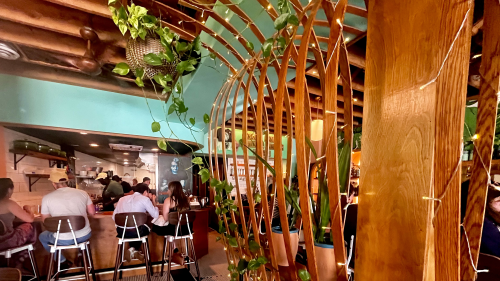What is a ghost sign? Think: old painted advertisements on the sides of buildings, usually spelling out the name of a company + a description of their goods or services. Given Madison’s rich history, 608 ghost signs are everywhere. Though many of these stories are lost to history, here’s what we learned about the signs on Madison’s quirkiest road — Willy Street.
Star Food Shop
Williamson Street + South Ingersoll Street
The Neo-Classical Revival building was constructed in 1904 for local grocers. Albert and Elmer Mills ran the store until it was occupied by Star Grocery in the 1950s. The grocer had the advertisement put on the corner to drive traffic to the local bakery.
The Gardner Baking Company had its home on East Washington Avenue, baking up fresh bread for the city. The Gardner’s Purity bread ad is a 1950s blue and yellow mural, featuring its signature Butter Yellow wrapper from the era. And Gardner still has its own sign on East Washington Avenue.
Madison Candy Co.
Williamson Street + South Livingston Street
Madison Candy Company found its home in the factory district of the Isthmus in 1903. The building — designed by local architect John Nader — housed the production of the sweets until 1927. The company was best known for its chocolate creams + sold its confections throughout Wisconsin and Illinois.
The red brick and limestone building with expansive arched windows was later occupied by the Wisconsin Farm Bureau and Ela Industry Supply Company throughout the mid-1900s. The sign was restored by John Martens, who bought the building from Ela in 1991 and is now home to one of Food Fight’s many restaurants.
King Midas Flour
Williamson Street + South Paterson Street
The Biederstadt-Breitenbach Grocery building was erected in 1874 after a fire burned down the lot’s original structure. The brick exterior lined building served as a grocery store and family home for the Biederstaedt and Breitenbach families until the 1950s.
The Breitenbach family leased the space after the death of the head of the Biederstaedt family. Quoted as “the busiest spot on the street,” the Breitenbach’s store was a popular candy counter and dry goods store. For the Biederstaedt legacy, the family built the Majestic in 1906, starting a series of vaudeville theaters in the Midwest.
While we weren’t able to find anything specifically on Krause, we’re guessing that the grocery and meat purveyor occupied the building before Screen Door Studio took over the space + were responsible for painting the King Midas Flour sign.
The Italianate building is a National Registration Historical Place and received landmark status from the Madison Landmarks Commission in 1977. The sign was restored by the co-owner of Cargo Coffee and the former Ground Zero coffee shops, which is currently seen today.













